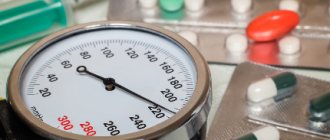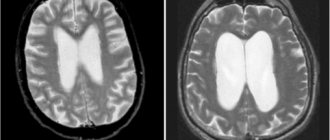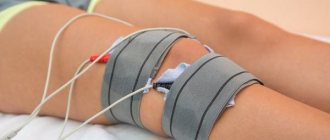21.12.2019
- August P. Management of hypertension in pregnant and postpartum women.
- GARETH BEEVERS D. ABC OF HYPERTENSION.
- Gibson P. Hypertension and Pregnancy.
- Rodriguez-Cruz E. Hypertension.
- Rodriguez-Cruz E. Hypertension.
- Dionne J. Hypertension in infants: diagnosis, management and outcome.
- Rodriguez M. Hypertensive crisis.
- Hypertensive Crisis. American Heart Association.
- Marik P. Hypertensive crises: challenges and management.
- Williams B. Guidelines for management of hypertension: report of the fourth working party of the British Hypertension Society, 2004-BHS IV.
- Williams B. Guidelines for management of hypertension: report of the fourth working party of the British Hypertension Society, 2004-BHS IV.
- Whelton P. Primary prevention of hypertension: clinical and public health advisory from The National High Blood Pressure Education Program.
- Mean Body Mass Index. World Health Organization.
- Brook R. Beyond medications and diet: alternative approaches to lowering blood pressure: a scientific statement from the American heart association.
- Williams B. Guidelines for management of hypertension: report of the fourth working party of the British Hypertension Society, 2004-BHS IV.
- Mente A. Associations of urinary sodium excretion with cardiovascular events in individuals with and without hypertension: a pooled analysis of data from four studies.
- Yokoyama Y. Vegetarian diets and blood pressure: a meta-analysis.
- Sacks F. Effects on blood pressure of reduced dietary sodium and the Dietary Approaches to Stop Hypertension (DASH) diet. DASH-Sodium Collaborative Research Group.
- Hartley L. Green and black tea for the primary prevention of cardiovascular disease (Review).
- Khalesi S. Green tea catechins and blood pressure: a systematic review and meta-analysis of randomized controlled trials.
- Liu G. Effects of tea intake on blood pressure: a meta-analysis of randomized controlled trials.
- Nancy J. Effect of increased potassium intake on cardiovascular risk factors and disease: systematic review and meta-analyses.
- Michael S. Potassium Intake, Bioavailability, Hypertension, and Glucose Control.
- Raebel M. Hyperkalemia associated with the use of angiotensin-converting enzyme inhibitors and angiotensin receptor blockers.
- Fahey T. Interventions used to improve control of blood pressure in patients with hypertension (Review).
- Colussi G. Impact of omega-3 polyunsaturated fatty acids on vascular function and blood pressure: Relevance for cardiovascular outcomes.
- Jain A. Omega-3 fatty acids and cardiovascular disease.
- Zhang X. Effects of Magnesium Supplementation on Blood Pressure: A Meta-Analysis of Randomized Double-Blind Placebo-Controlled Trials.
- Dibaba D. The effect of magnesium supplementation on blood pressure in individuals with insulin resistance, prediabetes, or noncommunicable chronic diseases: a meta-analysis of randomized controlled trials.
- Figueroa A. Influence of L-citrulline and watermelon supplementation on vascular function and exercise performance.
- Lima F. Effect of L-arginine intake on exercise-induced hypotension.
- El Hafidi M. Is glycine effective against elevated blood pressure?
- Díaz-Flores M. Oral supplementation with glycine reduces oxidative stress in patients with metabolic syndrome, improving their systolic blood pressure.
- Legarth C. The Impact of Vitamin D in the Treatment of Essential Hypertension.
- Amarasekera A. Vitamin D supplementation lowers thrombospondin-1 levels and blood pressure in healthy adults.
- Firoz T. Oral antihypertensive therapy for severe hypertension in pregnancy and postpartum: a systematic review.
- Musini V. Pharmacotherapy for hypertension in adults aged 18 to 59 years.
- Miczke A. Effects of spirulina consumption on body weight, blood pressure, and endothelial function in overweight hypertensive Caucasians: a double-blind, placebo-controlled, randomized trial.
- Tabrizi R. The Effects of Coenzyme Q10 Supplementation on Blood Pressures Among Patients with Metabolic Diseases: A Systematic Review and Meta-analysis of Randomized Controlled Trials.
- Grossman E. Should melatonin be used to lower blood pressure?
‘>
Basic concepts – blood pressure, blood pressure, high blood pressure, hypertension
Blood pressure is the pressure that blood exerts on the walls of blood vessels. Physically, this is the excess of fluid pressure in the circulatory system above atmospheric pressure. It is an important biomarker of vital activity1. Typically, pressure refers to blood pressure, although in addition to it there are also intracardiac, capillary and venous2.
Blood pressure can increase for various reasons, for example, during vigorous physical activity and in stressful situations. This increase in pressure is natural and usually not dangerous3. But if the blood pressure in the arteries is elevated for a long time without an external reason, this indicates a pathological condition, it is called arterial hypertension (hypertension)4.
According to statistics, hypertension in most cases is asymptomatic5 - that is, apart from the actual increased pressure in the arteries, there are no indications of pathology, the body is fully functional. However, research has confirmed that prolonged exposure to high blood pressure is a key risk factor in the development of coronary heart disease, stroke, heart failure, atrial fibrillation, peripheral arterial disease, vision loss, chronic kidney disease and even dementia6,7,8,9.
Types of hypertension - primary and secondary, causes of development and risk factors
Now in world practice, hypertension is classified into two types - primary and secondary10. In 90-95% of cases, we are talking about primary hypertension, which is defined as “high blood pressure due to specific lifestyle and genetic factors”11,12. Lifestyle factors with scientific basis include excess salt in the diet, excess body weight, smoking and alcohol consumption13,14.
The remaining 5-10% of cases of high blood pressure are diagnosed as secondary hypertension, which is defined as “high blood pressure due to an identifiable cause.” Among such reasons, the global scientific community includes, in particular, chronic kidney disease, narrowing of the renal arteries, as well as endocrine disorders due to the use of hormonal and contraceptive drugs15.
Measurement methods, normative indicators, diagnosis and treatment of high blood pressure
Blood pressure is determined by two measurements - systolic and diastolic pressure, which indicate the maximum and minimum values, respectively16. Current recommendations from the European Society of Cardiology (ESC) suggest that for most healthy adults, resting systolic blood pressure ranges from 100 to 130 millimeters of mercury, with diastolic blood pressure ranging from 60 to 80 millimeters of mercury17,18.
The same recommendations and current research show that systolic and diastolic blood pressure above 130/80 is elevated for most healthy adults, that is, a figure of 140/90 indicates the presence of hypertension (provided that the values are maintained at rest for a long time)19,20. For children, blood pressure readings may be different21, and studies show that a single blood pressure measurement has no diagnostic value - to detect hypertension, it is necessary to measure blood pressure at regular intervals over a 24-hour period22,23.
When identifying pathological high blood pressure (hypertension), lifestyle is taken into account, which in most cases is the main cause of changes in blood pressure readings24. The main tips are regular physical exercise, limiting salt intake, eliminating excess weight, switching to a healthy diet and eliminating alcohol from the diet. The effectiveness of these measures in normalizing blood pressure has been confirmed by multiple studies25.
Subsequently, if these measures do not provide the expected reduction in blood pressure, the specialist prescribes targeted drugs26,27. It has been scientifically proven that timely elimination of risk factors and treatment of high blood pressure (160/100 and above) significantly increases potential life expectancy28. Treatment of hypertension in the range from 130/80 to 160/100 involves other drugs and a different strategy - in patients with such problems, after normalization of pressure, a comprehensive improvement in the functionality of the body was also observed, but not as accentuated as with higher initial pressure values and not statistically significant significant impact on life expectancy29,30,31. These studies suggest that with non-critical increases in blood pressure, in most cases, normalizing lifestyle and diet is sufficient.
If there is no tonometer, what signs indicate high blood pressure?
Blood pressure may rise or fall during the day, returning to normal values. This is how our body reacts to various life circumstances: stress, anxiety, sports or relaxation. However, there are situations when the pressure rises sharply.
How can you tell if it has jumped if you don’t have a tonometer at hand? Is it just a headache that speaks to this?
Characteristic signs of high blood pressure
Let us immediately note that all of the following signs can be both a symptom of high blood pressure and other diseases. If you have encountered them more than once, they grow stronger and do not go away, you should definitely consult a doctor!
Headache
You can often hear that the main sign of high blood pressure is a sharp headache, usually in the back of the head (sometimes in the temples). However, it may not always occur. Hypertension is not just called the “silent killer.” The disease is asymptomatic for a very long time, which means that a person, without knowing it (unless, of course, he uses a tonometer from time to time), walks with high blood pressure. As a result, the body gradually adapts, and even consistently high values do not cause discomfort, including headaches.
- A person reacts with headaches only to changes in pressure, both in the case of a strong increase or decrease,
- If a person has consistently high values, for example, 160/100 mmHg. pillar, he doesn’t feel them. However, with an even greater increase in indicators and even with a decrease to standard values of 120/80 mm Hg. the person will feel bad.
Headache may also be a symptom of low blood pressure.
Memory impairment
High blood pressure affects memory and mental performance. Such people quickly get tired and tired. Due to high pressure, the small arteries of the brain suffer, and the blood supply to the brain is worse. This, in turn, alters normal brain function, leading to memory loss and other problems (such as stroke).
Deterioration of vision and the appearance of “floaters” before the eyes
With a sharp jump in blood pressure, vision can decrease and so-called black spots appear in the eyes. Many people attribute these symptoms to age-related changes or manifestations of other diseases.
When the pressure rises sharply, vascular spasm occurs, in which certain areas of the eye experience a lack of oxygen, which leads to the appearance of flickering “floaters”. When the indicators normalize, these symptoms disappear.
Increased heart rate
The heart rate changes (sometimes people describe the sensation as “heart pounding” or “heart pounding”). A rapid pulse, which can be easily felt when pressed lightly, indicates increased blood pressure.
Excessive sweating
If you do not suffer from hyperhidrosis, severe sweating may indicate a sudden increase in blood pressure. It is often accompanied by symptoms such as numbness of the hands, face, tongue, rapid pulse, shortness of breath, and pain in the heart. As a rule, when the pressure decreases to normal values, increased sweating goes away.
In addition, symptoms may appear associated with the reaction of the human vegetative-vascular system to a sharp rise in pressure:
- redness/pallor of the skin;
- frequent urination (every 5 minutes);
- acute diarrhea;
- feeling of temperature;
- nausea;
- hand trembling;
- wet and cold hands;
- noise in ears.
What to do if you don’t have a tonometer
Of course, only a tonometer can show exact values. However, in emergency cases, you can use the following method. You need to take a comfortable position, lean your back on the back of the chair, and relax. Then feel the pulse on your wrist and count the number of beats in 30 seconds. The result obtained must be multiplied by two. If the heart rate is less than or equal to 60, blood pressure is low, 60-80 beats per minute is normal, more than 80 is increased. In addition, if during the measurement you feel that the pulse is well felt, its rhythm is quite rapid, most likely your blood pressure is increased. The heart rate cannot be heard well, it is interrupted - it is below normal.
IMPORTANT! Without accurately measuring blood pressure with a tonometer, you should not take any medications or antihypertensive drugs.
Cardiologist V.M. Kravtsov
Prevalence of hypertension, signs and symptoms in different categories, hypertensive crisis
High blood pressure affects 16 to 37% of the world's population32. Recent statistics indicate that high blood pressure is responsible for an average of 20% of all annual deaths in the world, in particular - in 2010, 9.4 million people died from hypertension and the functional disorders caused by it (18% of all deaths that year) 33.
Common symptoms of high blood pressure are headaches (constant and periodic, especially in the back of the head in the morning), dizziness, tinnitus (buzzing and hissing), changes in vision, fainting34. However, studies show that self-diagnosis of hypertension is ineffective, since the described symptoms must be differentiated from a number of other pathologies35. Among the methods of physical diagnosis, examination of the fundus of the eye for the presence of retinopathy is recognized as the most objective36. In the presence of this pathology, the severity of retinopathy directly correlates with the severity of hypertension37.
The specifics of identifying secondary hypertension are different - along with general symptoms, target symptoms are identified that correspond to the original pathology, which is the cause of high blood pressure. For example, if obesity and impaired glucose metabolism occur against the background of the main symptoms, then we are often talking about Cushing’s Syndrome38. Also common causes are hyperthyroidism, renal artery stenosis, coarctation of the aorta, and pheochromocytoma39.
A special category is pregnant women; they have high blood pressure in 8-10% of cases40. In this condition, pressure is considered elevated and requires treatment if it is greater than 140/90 when measured repeatedly at 6-hour intervals41. The presence of high blood pressure in this case is diagnosed as pre-existing hypertension, gestational hypertension or preeclampsia42. The most dangerous is preeclampsia, which is further confirmed by the detection of protein in the urine. It is detected in 5% of pregnant women and is the cause of 16% of all deaths of women during childbirth43. It also doubles the child's risk of death. This is why identifying high blood pressure in pregnant women is a critical aspect of clinical surveillance44.
In children, high blood pressure can be diagnosed with any deviation from the norm 100-130/60-80 and is usually detected by external signs - irritability, difficulty breathing, convulsions, lethargy, minimal activity, underweight in newborns45. In children over 1 year of age, high blood pressure may present with headache, unexplained fatigue, blurred vision, nosebleeds, and facial paralysis46,47.
The most dangerous condition in hypertension is a hypertensive crisis. The condition is characterized by a critical increase in blood pressure - over 180 for systolic and over 110 for diastolic48. A hypertensive crisis requires immediate action, otherwise it can lead to organ damage and death49. The brain, kidneys, heart and lungs are most often affected in the event of a crisis, causing typical symptoms - chest pain, shortness of breath, drowsiness, confusion50. Considering the high risks associated with high blood pressure, the use of all known preventive measures to prevent or reduce the risk of pathological increases in blood pressure is justified.
Seven Real Causes of High Blood Pressure
Why, in fact, every second of us becomes hypertensive, experts say
Photo: Anastasia OSIPOVA
Blood pressure greater than 130/90 units is considered elevated. This condition is called arterial hypertension (AH). Moreover, in every tenth case, high blood pressure is a symptom of some other disease - conditions accompanied by pressure surges of about 70. Such hypertension is called symptomatic. So, your blood pressure rises above 130/80 units. Possible options:
1. Violation of vascular tone
The first step is to do research: a general blood test, a biochemical blood test, a general urinalysis, an ECG (cardiogram), if necessary, a chest X-ray, an ultrasound of the internal organs.
If, based on the results of tests and examination by a cardiologist, problems with blood vessels have been identified (impaired vascular tone of the hypertensive type), and otherwise you are a completely healthy person, then your problem is called “simple” hypertension. In this case, the main tasks are: undergo all the necessary cardiovascular examinations and correctly select a regimen of antihypertensive drugs to keep the pressure within the normal range.
2. Kidney problems
Blood pressure almost always increases with kidney disease. For example, if you have urinary disorders - pain, burning, frequent urge - it is likely that you have advanced inflammation in the pelvic organs or urolithiasis. In older men, increased blood pressure can worsen prostatitis.
3. Hormonal disorders
If the blood test shows a low potassium content, and high blood pressure is combined with muscle weakness, most likely it is a deficiency of the hormone aldosterone in the body, explains cardiologist Tamara Ogieva.
The pressure rises in attacks, the crisis is accompanied by pallor, sweating, increased heartbeat, trembling, is there weight loss, upset stool? Possible pheochromocytoma - a benign tumor of the adrenal glands.
4. Hangover
Increased blood pressure is one of the common symptoms of a hangover in completely healthy people. The breakdown of alcohol causes spasms of blood vessels in the brain, which gives rise to hypertensive symptoms. In this case, it is possible to take an antispasmodic (spazgan, spasmalgon, baralgin), which will relax the blood vessels and at the same time relieve pain.
5 Popular drugs
It turns out that taking popular painkillers can cause not only stomach problems (they irritate the mucous membrane - it’s no longer a secret), but also a hypertensive crisis. Especially if you suffer from high blood pressure. Scientists from Tel Aviv University have concluded that painkillers may be the cause of hypertension, which is known to increase the risk of strokes and heart attacks.
There are painkillers, the side effect of which is an increase in blood pressure (this is honestly written in the instructions, but who reads it when you urgently need to relieve pain). Cardiologist Tamara Ogieva says that these include medications with paracetamol and caffeine. By the way, they can weaken the effect of antihypertensive drugs (that is, medications that are prescribed to hypertensive patients for blood pressure). So be careful.
6. Some products
It turns out that blood pressure can suddenly jump after a hearty lunch. Especially if you've eaten too much salty food. Salt is known to retain fluid in the body, which invariably leads to increased stress on the blood vessels.
Moreover, in addition to herring and sauerkraut, the culprits of “food” hypertension may be products with so-called hidden salt - raw smoked sausages, salted cheeses such as suluguni or aged cheeses such as parmesan, red caviar. Coffee and energy drinks, fortified wines, vermouths, and beer also increase blood pressure. Drinks with a sour taste are reduced - fruit drinks, tea with lemon, a glass of light dry wine.
7. Sore back
Do not be surprised if the cardiologist, if you complain of heaviness in the back of the head and high blood pressure, sends you for an x-ray of the cervical spine. Osteochondrosis or the consequences of untreated back injuries often lead to hypertension, says orthopedist Sergei Goryachev. The reason is that due to damage to the vertebrae, constant tension is created in the muscles of the back and neck. And this can cause spasms in the blood vessels of the neck and disruption of brain nutrition.
By the way, an increase in pressure in the evening is often associated with an improperly equipped workplace, when you also have to greatly strain the eye muscles.
IMPORTANT!
Additional examination is always needed if:
- hypertension suddenly appeared after 60 years of age,
- the pressure increased suddenly and immediately to high numbers,
- Drug treatment does not help.
CHECK YOURSELF
Blood pressure standards developed by WHO:
Reduced normal - 115-110/70 mm Hg. Art.
Optimal - 120/80 mmHg. Art.
The upper limit of normal is 130-139/85 mm Hg. Art.
Arterial hypertension - from 140/90 mm Hg. Art. and higher.
ON A NOTE
10 reasons why you are at risk of hypertension
The sad truth of life is that more and more often people who have just reached their fourth decade are forced to take blood pressure medications. And there are many who are long overdue for a prescription, but people are not even aware of their incipient health problems. It just doesn’t occur to many people that, for example, hypertension can strike at such a young age. Meanwhile, almost all of us are faced with factors that increase the likelihood of developing high blood pressure. Here are just the most common of them (details).
5 unexpected reasons for high blood pressure
40 million people in Russia are hypertensive. According to official estimates, every third resident of our country over 30 years of age periodically suffers from attacks of high blood pressure. Experts explain why, in addition to cardiovascular diseases, the tonometer numbers go off scale (details).
How to lower blood pressure without medications
If your doctor has diagnosed you with hypertension and prescribed appropriate treatment, you can try to lower your blood pressure naturally. Here are seven simple and reliable ways (details).
Which drinks raise and which lower blood pressure?
Experts told us what is healthier to drink for hypertensive patients and what for hypotensive patients (details).
BY THE WAY
Cats reduce blood pressure
Stroking a cat's fur is believed to lower blood pressure. Mysticism aside, there is a scientific explanation for this (details).








